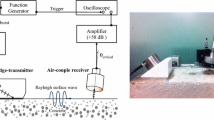Abstract
Concrete, when exposed to high temperatures, presents important changes in its properties of strength and deformation and, in extreme situations, these alterations can constitute risks to the integrity and the safety of the structures. This work presents extensive campaign with 70 cylindrical specimens and seven different mixture proportions: two of mortar and five of concrete, to analyze the propagation profile of longitudinal and transverse ultrasonic waves in concrete cylindrical specimens, associating the variation of the ultrasonic pulses with the level of compression stresses and the degree of damage imposed by high temperature. The compressive strength was within the range of 32 and 64 MPa and the specimens were exposed to temperatures of 250°, 300° and 350°C. The results indicate that longitudinal and transverse ultrasonic waves can be successfully applied in the evaluation of diffuse damage cause by uniaxial compression load and exposure to high temperatures.






Similar content being viewed by others
REFERENCES
Balaji, K.V.G.D. and Raju, S.S.S.V.G., Nondestructive assessment of concrete structures exposed to fire, Int. J. Appl. Environ. Sci., 2009, vol. 4, no. 1, pp. 25–31.
Crawford, G.I., Guide to Nondestructive Testing of Concrete, FHWA–SA–97–105,Federal Highway Administration, Washington, D.C., USA, 1997.
Erdoğdu, Ş., Kandil, U., Nas, M., Kurbetci, Ş., and Nayir, S., Ultrasonic pulse velocity and compressive strength evaluation of concrete containing fly ash exposed to high temperatures, Nevsehir J. Sci. Tech., 2017, vol. 6, pp. 314–325.
Güneyli, H., Karahan, S., Güneyli, A., and Yapιcι, N., Water content and temperature effect on ultrasonic pulse velocity of concrete, Russ. J. Nondestr. Test., 2017, vol. 53, no. 2, pp. 159–166.
Lima, R.C.A., Investigação do comportamento de concretos em temperaturas elevadas, PhD Thesis, Porto Alegre, Brazil: Univ. Fed. do Rio Grande do Sul, 2005.
Handbook on Nondestructive Testing of Concrete, Malhotra, V.M. and Carino, N.J., Eds., CRC Press, 2004. 2nd Ed.
Mehta, P.K and Monteiro, P.J.M., Concreto: Microestrutura, propriedades e materiais (Concrete: Microstructure, properties and materials), São Paulo, Brazil: IBRACON, 2014.
Musmar, M.A. and Alhadi, N.A., Relationship between ultrasonic pulse velocity and standard concrete cube crushing strength, J. Eng. Sci., 2008, vol. 36, no. 1, pp. 51–59.
Nogueira, C.L. and Willam, K.J., Ultrassonic testing of damage in concrete under uniaxial compression, ACI Mat. J., 2001, vol. 98, no. 3, pp. 265–275.
Popovics, S., Rose, J.L., and Popovics, J.S., The behavior of ultrasonic pulses on concrete, Cem. Concr. Res., 1990, vol. 20, no. 2, pp. 259–270.
Filho, L.C.P.S., Lorenzi, A., Campagnolo, J.L., Strieder, A.J., Quinino, U.C.M., and Caetano, L.F., Case studies on evaluation of concrete structures using non–destructive tests, Rev. Alconpat, 2011, vol. 1, no. 3, pp. 186–198.
Tharmaratnam, K. and Tan, B.S., Attenuation of ultrasonic pulse in cement mortar, Cem. Concr. Res., 1990, vol. 20, no. 3, pp. 335–345.
Trtnik, G., Kavcic, F., and Turk, G., Prediction of concrete strength using ultrasonic pulse velocity and artificial neural networks, Ultrasonics, 2009, vol. 49, no. 1, pp. 53–60.
Udegbunam, O., Yaman, I.O., Aklan, H., and Hohm, T., Developing a rapid measure of concrete permeability for use in QNQC specifications, Proc. Transp. Res. Board, Paper no. 990565, 1999.
Woods, R.D., Screening of surface waves in soils, ASCE J. Soil Mech. Found. Div., 1968, vol. 94, no. 4, pp. 951–980.
ACKNOWLEDGMENTS
Authors thank Capes and CNPq for their financial support, essential for the conclusion of this major step forward. Also thanks to Senai and Letmacc (Civil Construction Materials Technological Test Laboratory), especially to coordinator Ana Paula Alencar for her friendship, efficiency and offering the laboratory to perform the technological tests. Also to laboratory technicians David Macedo, Felipe Clayton and Nelson Martins for their vital, help in carrying out the tests.
Author information
Authors and Affiliations
Corresponding authors
Rights and permissions
About this article
Cite this article
Silva, F.A., Nogueira, C.L., Silva, J.A. et al. Ultrasonic Assessment of Damage in Concrete under Compressive and Thermal Loading Using Longitudinal and Transverse Waves. Russ J Nondestruct Test 55, 808–816 (2019). https://doi.org/10.1134/S1061830919110081
Received:
Revised:
Accepted:
Published:
Issue Date:
DOI: https://doi.org/10.1134/S1061830919110081




